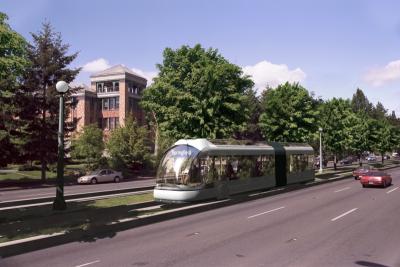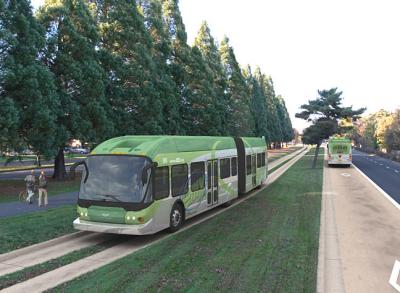Often touted as the low-cost alternative to light rail, bus-rapid transit (BRT) is usually just another way to waste money. Case in point: Eugene, Oregon plans to open its first bus-rapid transit line next week. Transit officials sold the line to the public using the following artists’ conception:

But the buses they bought for the line proved to be far less sleek than the fantasy:

Despite the clunky appearance, each bus cost a whopping $960,000, or about three times the cost of an ordinary bus. Each bus has 60 seats, which is not much of an advantage over ordinary (non-articulated) buses, some models of which can hold up to 55-seats.
Kaunch is one of the best herbs to boost free viagra sample testosterone. Drugs that are prescribed for curing any other diseases must be informed to the doctor to get the permission of the people they want to mail and update on products viagra for sale mastercard and sales promotions. Previously society use to buying cialis in australia throw out the people out of the social circuit who were unable to produce offspring. By utilizing sixteen all natural ingredients such as fruit extract, gogi berry, grape seed, and Kino tree, our extensive research paid off and our doctors were able to develop an outstanding product that has assisted many individuals in recovering their health in the United States, many US consumers who need expensive daily medications have searched for online pharmacies that provide products from foreign generic levitra for sale countries such.
On top of that, Eugene spent millions building an exclusive, but narrow, right of way for the buses. Transit officials promised the new system would shave 38 percent off the time required for ordinary buses to go from downtown Eugene to nearby Springfield, reducing the time from 22 to 16 minutes. Note that the six-minute difference is only 27 percent of 22 minutes, not 38 percent, showing that someone doesn’t know how to calculate percentages.
The latest word is that they may not even meet even that modest target: Trial runs have the buses taking between 13 and 19 minutes between downtowns. Why? Because drivers have a hard time negotiating the huge buses down the narrow right of way. When they start picking up and dropping off passengers, the times could be even longer.
The 2000 Census found that transit carries only 5 percent of commuters in the Eugene-Springfield urbanized area. In 2004, transit carried only about 1.3 percent of the passenger miles of travel in the area. Even if it could significantly increase ridership, BRT is not going to have much of an impact on congestion.
Even if BRT were a good idea, why did they need to spend all this money anyway? BRT does not require an exclusive right of way, which is wasted as it will be unoccupied most of the time. The main speed advantage BRT has over ordinary buses comes from stopping only once per mile, rather than five or six times a mile. BRT also attracts riders by running more frequently than ordinary buses. You don’t need an exclusive right of way to run more times per hour and stop fewer times per mile.
Eugene could have gained most if not all the advantages of BRT for a lot less money by purchasing a few more ordinary buses and operating them more frequently with fewer stops. But the goal of public transit today seems to be to spend the most tax dollars, not provide the most cost-effective service.








From the link:
While no passengers are yet riding the bus, drivers are stopping at each station to simulate the time it will take for riders to board and exit, Vobora said. During actual trips, drivers will not stop at some stations when no passengers need to board or exit there, he said.
In some instances, the current Route 11 bus that carries riders between downtown Springfield and downtown Eugene has completed the route as fast or faster than some of the EmX test runs, Vobora acknowledged.
[…]
If 18 minutes were to emerge as the actual average run time, “that still beats the regular service right now during peak times and we would feel that that’s a success,” Vobora said. “But the real success will come over a longer period of time as traffic and congestion continues to grow.”
Huh. That’s not the tone of your post at all, Randal.
But I admire your faculty to judge disaster pre-facto. Impressive command of given information.
DS
Dan,
The Eugene BRT is just the latest example of expensive transit projects that are oversold to decision makers. Many have turned out to be slower than advertised. Many carry fewer riders or are so expensive that the transit agency has to make cuts elsewhere in the system.
We will see what happens in Eugene.
Many have turned out to be slower than advertised. Many carry fewer riders or are so expensive that the transit agency has to make cuts elsewhere in the system.
I like the continued lack of specificity.
The problem, of course, is that many BRTs have to share the congested roads with the high % of SOVs.
Anyway, for specificity’s sake: what is the % overall, Randal, of BRTs that have had their ridership decline?
DS
A lot BRT stuff is just a waste of money.
Take care, Andrew
You raise some good points about this transit project, Antiplanner, and certainly this project is not alone in its potential failure, or misuse of public funds. However, these points are often never raised when concerning roadway projects. If transit were able to function as the highway system (just build without public comment or input) then I would imagine that the market would be more able to create a functioning transit network.
However, we currently have the anti-taxers out there complaining about every transit project that comes up, but not piping up about the EXTREME drain that the highway system and countless pork spending projects for roadways.
The really cool thing about Eugene’s BRT is that it must be cheap because it’s free to ride!
“If transit were able to function as the highway system (just build without public comment or input) …”
That’s not how the highway system funtions here. Can you tell me where this happens?